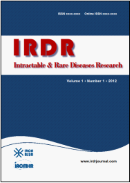BioScience Trends. 2024;18(6):584-598. (DOI: 10.5582/bst.2024.01277)
Laparoscopic versus open liver resection for intrahepatic cholangiocarcinoma: Stratified analysis based on tumor burden score
Li HX, Kong JJ, Si W, Wang T, Ji M, Li GB, Liu J
The role of laparoscopic liver resection (LLR) for intrahepatic cholangiocarcinoma (ICC) remains debated. This study aimed to evaluate the short- and long-term outcomes of LLR vs. open liver resection (OLR) in ICC stratified by tumor burden score (TBS). ICC patients who underwent LLR or OLR were included from a multicenter database between July 2009 and October 2022. Patients were stratified into two cohorts based on whether the TBS was > 5.3. A 1:3 propensity score matching (PSM) analysis was performed between LLR and OLR in each cohort. Cox regression analysis was used to identify prognostic factors for ICC. A total of 626 patients were included in this study, 304 and 322 patients were classified into the low- and high-TBS groups, respectively. In the low-TBS group, after PSM, LLR was associated with less blood loss, lower CCI, fewer complications and shorter hospital stay (all p < 0.05). Kaplan-Meier curves revealed that LLR had better OS (p = 0.032). Multivariate Cox regression analysis showed that surgical procedure was an independent prognostic factor for ICC (HR: 0.445; 95% CI: 0.235-0.843; p = 0.013). In the high-TBS group, after PSM, LLR were associated with reduced blood loss, lower CCI, fewer complications and shorter hospital stay (all p < 0.05), while OS (p = 0.98) and DFS (p = 0.24) were similar between the two groups. TBS is an important prognostic factor for ICC. LLR is a safe and feasible option for ICC and leads to faster postoperative recovery. LLR can offer ICC a comparable and even better long-term prognosis than OLR.







